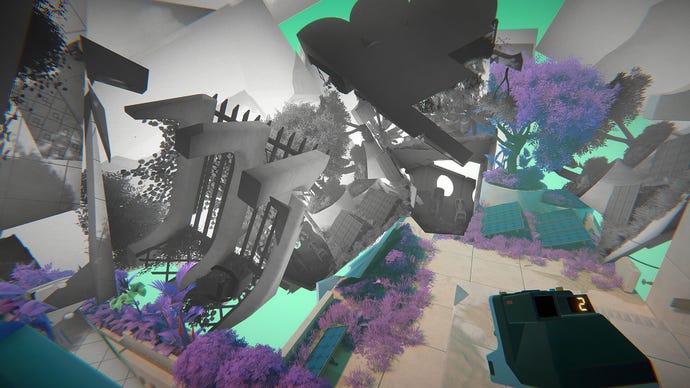Viewfinder review: a mind-bending puzzler where perspective is everything
Thinking outside the frame
In Viewfinder, you solve puzzles by figuring out the right way of looking at things, and you do that here by both physically moving around its abstract 3D spaces, and by mentally wrapping your brain around its mind-bending rule set. Perspective is key because here's the thing: this is a world where you can bring photos to life, the 2D image becoming a 3D reality when you place it within the puzzle world.
It's an incredible hook and one which I've never seen in a puzzle game before. There are echoes of The Witness, Gorogoa, and Superliminal here, but Viewfinder's dizzyingly mind-melting puzzles are still very much its own. It impresses from the get-go and continues to pull tricks out of its silky tophat right until the end of its four hour run time. It's compact, brilliant, and one of the best puzzle games of 2023.
The goal of every Viewfinder puzzle is to navigate a space to get to a teleporter that will take you to the next level. There are hub worlds with strings of puzzles, and if you complete each string the next hub world will unlock. But here's the fun part. To get to each teleporter you'll need some help from your magical photographs. When you hold up a photo in front of you, the structures and objects in the picture will materialise into the world in front of you.
The rules of puzzles change over time. Sometimes you have to take photos yourself, other times you can only use photos you find throughout the level. Occasionally your camera might have the capacity to take five photos, but in particularly difficult puzzles it'll only have one. The teleporters will often need a power source, too, meaning you'll need to find and collect batteries along the way. The rules may change within each string of puzzles, but they all remain wonderfully weird, totally off the wall, and oh-so-satisfying to solve.
Is it strange to say that Viewfinder makes me feel like a magician? It's the flair of it all: watch me materialise a chunk of this concrete skyrise out of thin air! It's such a playful game that begs to be messed around with, and it can get really bonkers in later levels. I’ve used snippets of stone structures to build pathways, taken snapshots of desks and benches to make walkways, and I’ve even used photos of the sky to make entire walls completely disappear. When you fully realise the power you wield, you start to look at the world differently. I was constantly looking for anything with a straight edge to make platforms or any piece of furniture that would be suitable as a makeshift flight of stairs.
.jpg?width=690&quality=80&format=jpg&auto=webp)
.jpg?width=690&quality=80&format=jpg&auto=webp)
It’s a subtle but impactful realisation. I first began making simple ramps and bridges, but by the end, I was dismantling and rebuilding entire levels, replacing the level’s set architecture with my own ideas and visions. I’ve completed puzzles in such a bizarre way it looks like someone smushed a bunch of MC Esher sketches together.
That’s just one of Viewfinder’s trippy ideas, but they evolve in so many other directions. There’s one set of puzzles where you discover that when you place a photo it’s not just the surface of that picture that gets materialised, but the entire world within it. Took a snapshot of a maze? Place it into the world and you can move through it and find a hidden prize at its core. Each photo is its own space for you to explore, like a gateway to another world.
.jpg?width=690&quality=80&format=jpg&auto=webp)
It's a sentiment that I remember clearly when playing Gorogoa: you need to start thinking about what lies beyond the frame of the photo and how you can use that for the puzzle at hand. There are also parts where you need to align your vision in a specific way to make a doorway to the next level, which is very much like The Witness. It's a great surprise seeing the developers find new ways of breaking boundaries, and it's impressive every time.

Viewpoint encapsulates a 'learn by doing' philosophy. It's just as much a virtual toy as it is a puzzle game. There's an easy rewind system to go back in time, making those mistakes vanish just as easily as they appeared, meaning you can mess around to your heart's content.Image credit: Thunderful Publishing
Viewfinder does have a story explaining this extraordinary power, but it's very hands-off. It's not a spoiler to say that the world you inhabit has been created by scientists who are using it as a space to carry out their research, and if you listen to the voice recordings strewn about, you'll discover they’re on the brink of a big discovery, one that will change the real world forever.
This narrative dressing didn't blow me away as much as its puzzling did, but it still made for a nice backdrop to the world. I also love that each hub world belongs to a specific researcher and acts as a window in their personality. One seems to have a sweet tooth from all the chocolate, tea, and cake on display, while another loves plants, turning her hub world into a massive garden. They all seem to be good friends and leave cute sticky notes for each other, too, and there’s a general untidiness to these researchers' spaces that makes each area feel like it's been loved and lived in. It’s all very calming and peaceful - even the menu music is lovely.
.jpg?width=690&quality=80&format=jpg&auto=webp)
Viewfinder is a puzzle game like no other. A reality-warping, mind-bending hook keeps it constantly interesting, and it consistently wowed me with the directions it goes in. It’s a game that makes me wish I could erase my memory and play it for the first time all over again.
This review is based on a review build of the game provided by the publisher Thunderful Publishing.









